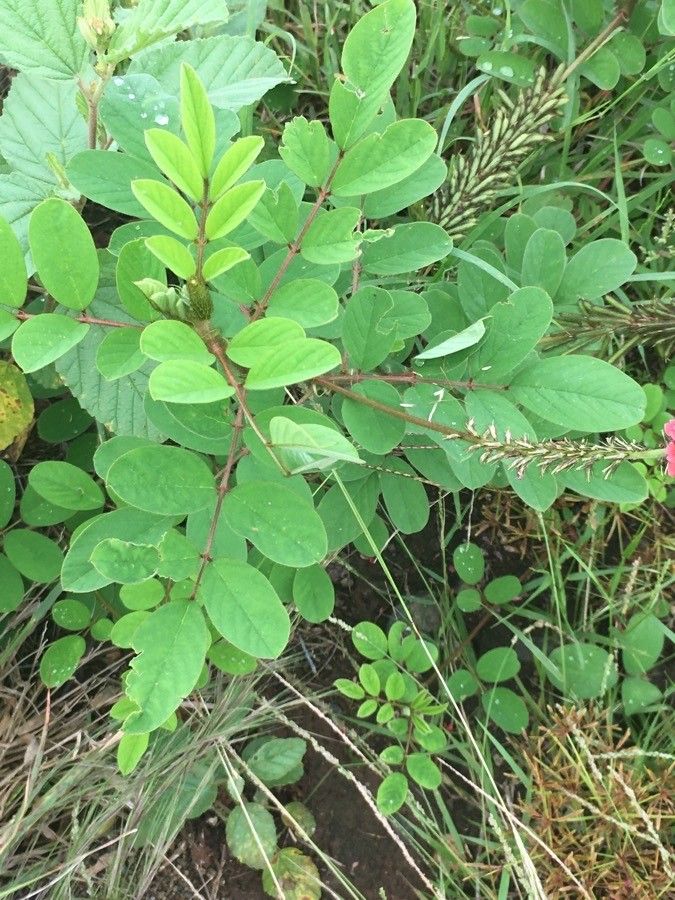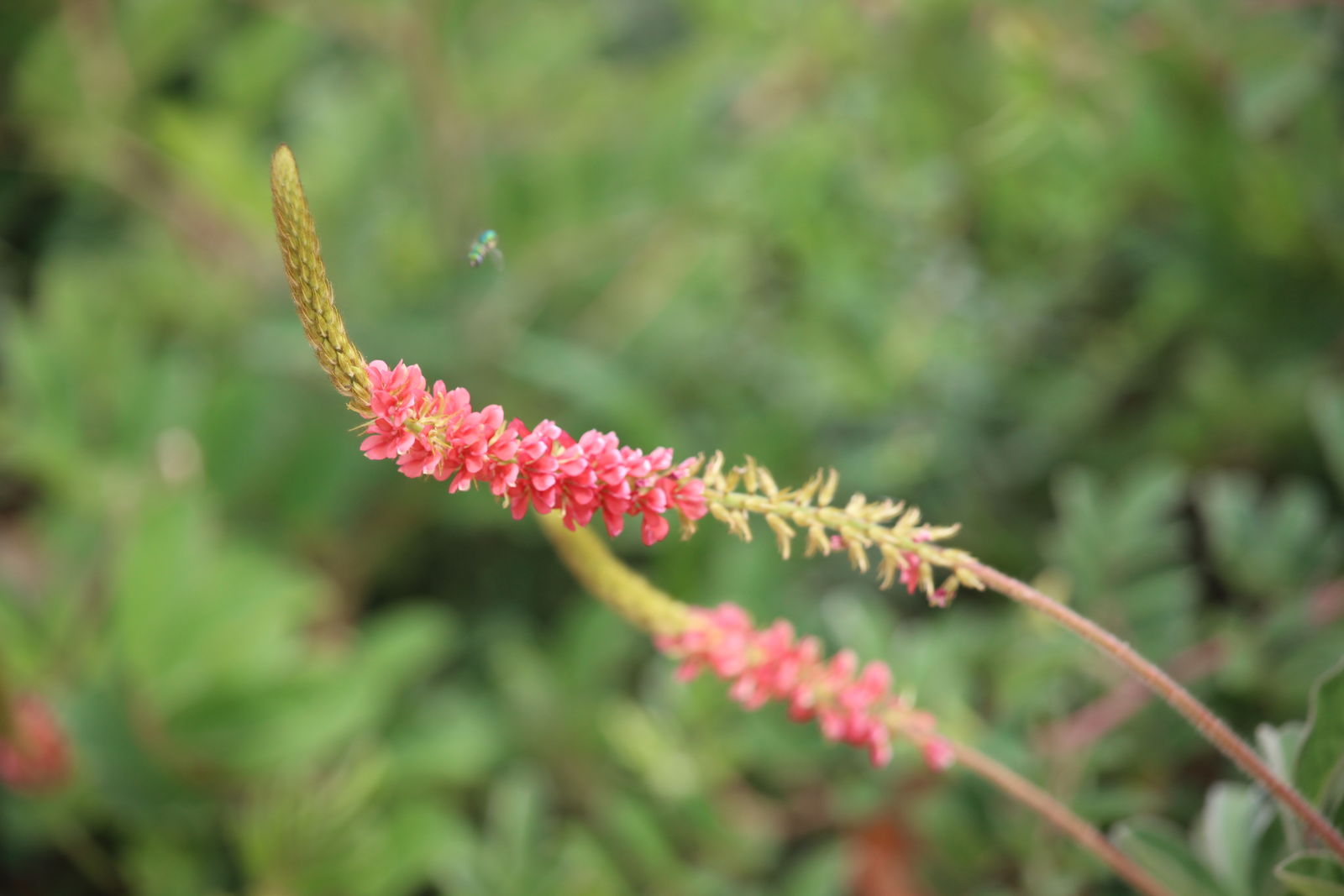Hairy Indigo
indigofera hirsuta
Also known as: ["Hairy Indigo","Hairy Indigobush"]
Overview
A leguminous shrub native to tropical regions, known for its hairy stems and leaves and purple flowers.
Benefits & Perks
["drought tolerant","wildlife attractant (bees, butterflies, birds)","nitrogen fixing"]
Botanical Classification
| Phylum: | Magnoliophyta |
| Class: | Magnoliopsida |
| Order: | Fabales |
| Family: | Fabaceae |
| Genus: | Indigofera |
| Botanical Name: | Indigofera hirsuta |
Plant Characteristics
Basic Information
- Category: Shrubs
- Suitable Location: outdoor garden bed in temperate to tropical regions
- Suitable For:
- Is Weed: No
- Allergenicity: low
Environmental Needs
- Climate: {"temperatureRange":"10–35°C"}
- Hardiness: {"zones":"9–11"}
- Misting: rarely required, only if ambient humidity is very low
- Drainage: Fast-draining to prevent waterlogging.
- Soil Type: Well-draining, loamy soil with organic matter; can tolerate poor soils but thrives with amendments.
Maintenance Level
- Maintenance Level: moderate
- Toughness Level: moderate
- Pruning Frequency: Light pruning can be done anytime; major pruning in late winter or early spring before new growth.
- Pruning Intensity: Moderate; remove up to one-third of the plant if needed for rejuvenation.
Care Details
Ideal Sunlight Coverage:
Full sun to partial shade (6–8 hours of direct sunlight daily); tolerates some afternoon shade in hot climates.
Sunlight Tolerance Tips:
Acclimate gradually to intense sunlight; protect from harsh afternoon sun to prevent scorching; adjust placement based on indoor/outdoor conditions.
Care Requirements
Care Difficulty
moderatemoderate
Sunlight
full sun to partial shade
Rotate plant for even light exposure; use sheer curtains to filter intense sun; monitor for signs of sunburn.
Watering
every 7–10 days during active growth, reduce in winter
Water thoroughly but infrequently; ensure soil dries between waterings; avoid overwatering.
Soil
well-draining, loamy soil with moderate organic matter
pH: Slightly acidic to neutral (pH 6.0–7.0).
Avoid heavy clay soils; ensure pots have drainage holes; test soil pH periodically.
Temperature
Prefers warm temperatures (65–85°F or 18–29°C); thrives in tropical to subtropical climates.
Avoid sudden temperature changes; protect from frost; ensure good air circulation in hot weather.
Fertilizing
every 4–6 weeks during growing season, none in winter
Avoid over-fertilizing to prevent root burn; apply fertilizer to moist soil; flush soil occasionally to prevent salt buildup.
Propagation
Methods
Stem cuttings or seeds; stem cuttings are more reliable for home growers.
Step-by-Step Propagation Guide
- Take a 4–6 inch cutting.
- Remove lower leaves.
- Apply rooting hormone.
- Plant in medium.
- Keep moist and warm.
Best Time: Spring or early summer when the plant is actively growing.
Environment
Warm, humid environment with indirect light; maintain consistent moisture.
Medium
Well-draining potting mix (e.g., perlite and peat moss) or water for initial rooting.
Hormone
Rooting hormone is recommended to improve success rates.
Timeline
Roots may develop in 3–6 weeks; new growth indicates establishment after 2–3 months.
Tools Needed
Pruning shears, rooting hormone, small pots, well-draining medium.
Quick Tips
Use healthy, non-flowering stems; keep cuttings out of direct sun; maintain humidity with a plastic bag if needed.
Pruning & Repotting
Pruning Guide
Method
Use clean cuts just above a leaf node or branch junction; remove crossing or crowded branches.
Pruning Plan
Prune to maintain shape, encourage bushiness, and remove dead or diseased growth.
Tools
Pruning shears, sterilizing solution, gloves.
Checklist
Sterilize tools; prune dead/damaged growth; shape the plant; clean up debris.
Repotting Guide
Best Season
Spring, before the active growing season begins.
Pot Size
Choose a pot one size larger (1–2 inches wider) than the current one.
Method
Remove plant gently; trim roots if necessary; place in a new pot with fresh soil; water lightly.
Suggestions
Repot every 2–3 years or when roots fill the pot; beneficial for growth and soil health.
Checklist
Select new pot; prepare fresh soil; inspect roots; water after repotting; place in appropriate light.
Advanced Care Tips
Watering Mastery
Watering Checklist
Check soil moisture; water deeply; ensure drainage; adjust for season.
How to Apply Water Properly
Water at the base of the plant, ensuring moisture reaches the root zone; allow excess water to drain away; water in the morning to reduce evaporation.
Watering Schedule Tips
Water deeply once the top inch of soil is dry; reduce frequency in winter to prevent root rot.
Soil Improvement
Add perlite or sand for drainage; incorporate compost for fertility; ensure good aeration.
Temperature Stress Management
Signs of Temperature Issues
Wilting, leaf drop, or chlorosis in cold; scorching or stunted growth in excessive heat.
Cold Stress
Low temperatures slow growth and may cause leaf drop or dormancy; frost can damage or kill the plant.
Solution: Protect from frost with a cover; move potted plants indoors; avoid cold drafts.
Hot Stress
Excessive heat can lead to wilting, leaf scorch, or reduced flowering; may require increased watering.
Solution: Provide shade during peak heat; increase humidity; water early in the day.
Fertilizing Guide
Fertilizing Checklist
Check fertilizer type; dilute correctly; apply during growing season; monitor for signs of over-fertilization.
Fertilizing Method
Use a balanced, water-soluble fertilizer diluted to half strength; fertilize every 4–6 weeks during growing season (spring to summer); reduce or stop in fall and winter.
Common Problems & Solutions
Toxicity Warning
Cats
ToxicIndigofera hirsuta is toxic to cats due to its quinolizidine alkaloid content. These compounds can disrupt normal bodily functions, leading to serious health complications, particularly affecting the nervous system.
⚠️ Symptoms:
🌿 Toxic Parts:
⚡ Toxic If:
if eaten
Dogs
ToxicThe quinolizidine alkaloids present in Indigofera hirsuta are toxic to dogs, causing significant physiological disturbances. Ingestion can lead to severe gastrointestinal and neurological symptoms.
⚠️ Symptoms:
🌿 Toxic Parts:
⚡ Toxic If:
if eaten
Humans
ToxicIndigofera hirsuta contains quinolizidine alkaloids, which can cause toxic effects when ingested. These compounds interfere with normal physiological processes, particularly affecting the nervous system and potentially leading to severe health issues.
⚠️ Symptoms:
🌿 Toxic Parts:
⚡ Toxic If:
if eaten
Frequently Asked Questions
Q: Is Indigofera hirsuta toxic to pets?
A: It is mildly toxic to dogs and cats if ingested.
Q: Does Indigofera hirsuta attract wildlife?
A: Yes, it attracts bees, butterflies, and birds.
Q: Is Indigofera hirsuta suitable for beginners?
A: It requires moderate care, so it is not ideal for beginners.
Quick Reference
| Family: | Fabaceae |
| Care: | moderate |
| Light: | full sun to partial shade |
| Water: | every 7–10 days during activ |
Get Expert Care Tips
Download the Plantious app for personalized care reminders and plant identification!
Google Play App Store








